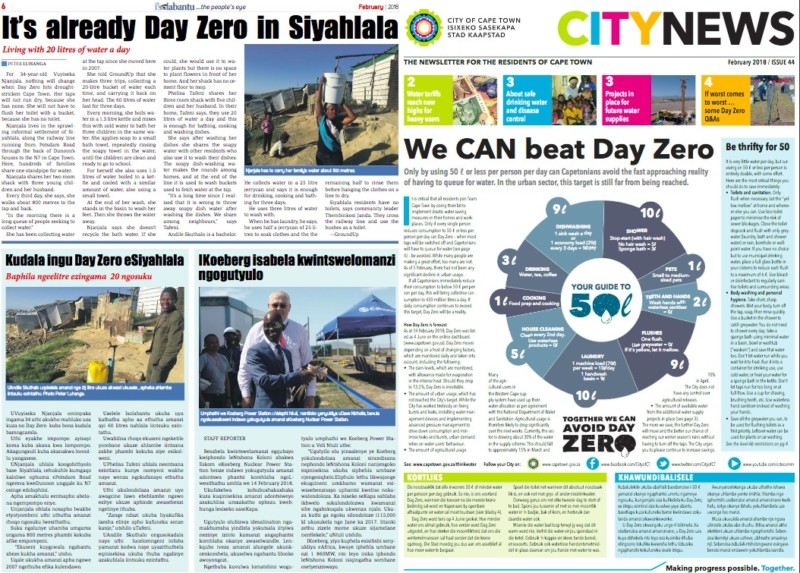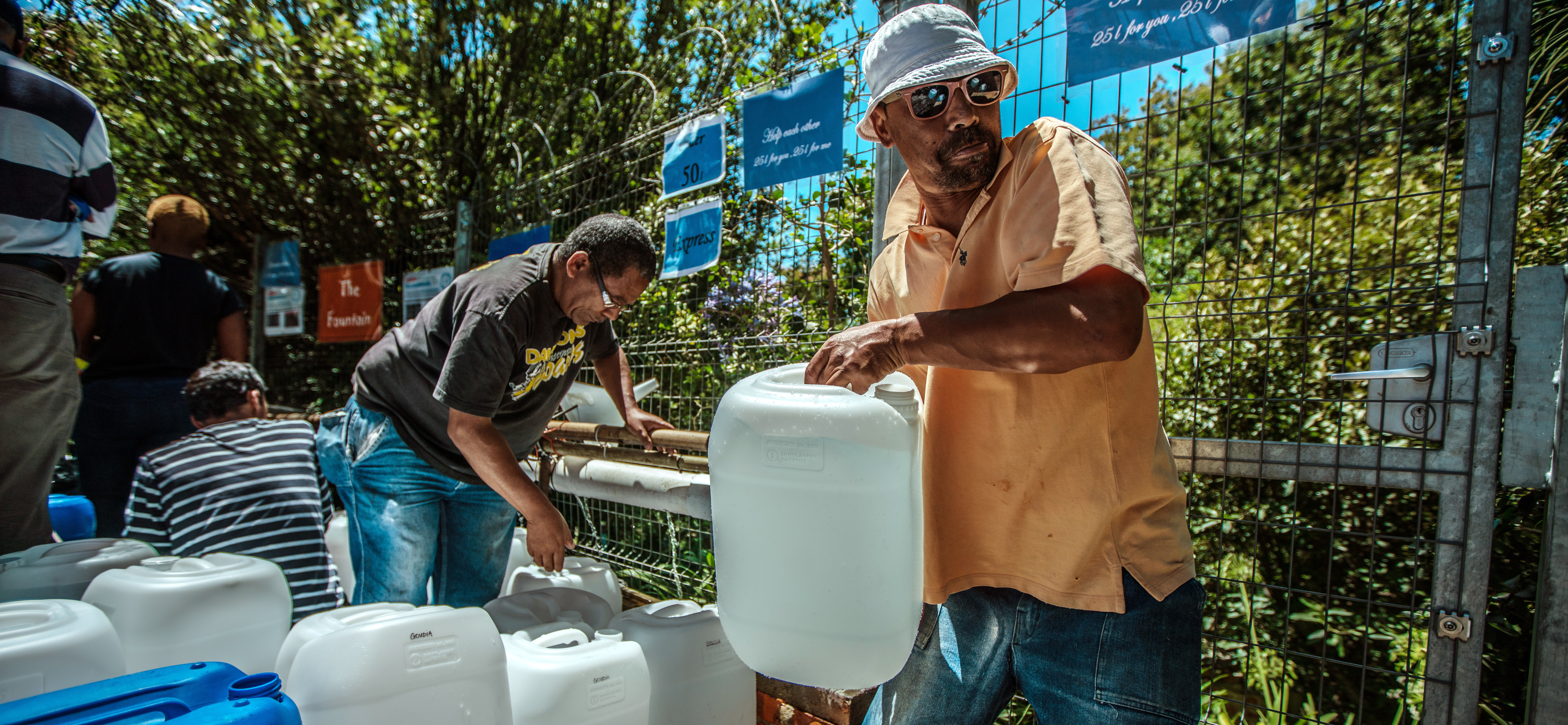Sign up for The Media Today, CJR’s daily newsletter.
Inside February’s edition of Isolabantu News, a free monthly newspaper in Cape Town, an insert paid for by municipal officials screamed, “We CAN beat Day Zero”—a reference to the impending threat of water outage in the city. A story on the opposite page, “It’s already Day Zero in Siyahlala,” took a very different tone, explaining in English as well as the local isiXhosa language that little would change for Cape Town’s poorest residents should the city turn off the taps.

Screenshot from the February 2018 Isolabantu News.
Many other stories about the crisis, in South Africa and overseas, featured images of middle-class Capetonians lining up by Table Mountain to bottle water from natural springs, a collective bid to spare the municipal supply. In many of the poorer townships and informal settlements that sprawl toward the ocean, however, waiting at a communal water source has been a fact of life for many years. “People [there] were not scared at all” of Day Zero, Isolabantu News Managing Editor Peter Luhanga says. “In the Eastern Cape, people walk a long distance just to get to a nearby freshwater source. Here, it’s heaven, because there’s a freshwater tap, which they share.”
ICYMI: Reporters must convey the perils of climate change without paralyzing their audience
The Isolabantu News spread summarized these sharp disparities. The local Siyahlala story, written by Luhanga, showed how hysteria about taps running dry failed to resonate with those who don’t have taps. Most national and international coverage of the crisis, by contrast, reflected the panicked official messaging across the fold. From late January to early March, the world watched with bated breath as—for the first time—rich residents of a major metropolis raced against the clock to reduce their water consumption and avert catastrophe.
Then came… nothing much. As quickly as reporters rushed to Cape Town when Day Zero was declared, most lost interest when, in March, officials said it wouldn’t happen in 2018 after all—even though the announcement looked like a product of municipal politicking. Climate science, and its effect on the global poor, was relegated to its habitual, secondary status. Some still worry that by conjuring and then swiftly allaying short-term fears, “Day Zero” stymied a much-needed, longer-term conversation about water. While Cape Town’s local media remains conscious of the city’s ongoing fragility, the story has not set an urgent agenda in South Africa or on the global stage.
As Cape Town’s water supply dwindled through years of drought, the idea of “Day Zero” slowly gained currency among some local residents, researchers, and officials. It wasn’t until January 2018, however, that Mayor Patricia de Lille announced, with high drama, that it was coming up fast on the rails. The city launched a newly aggressive PR campaign, targeted mostly at richer residents. (The roughly 50 percent of Capetonians who live in poor settlements use only 5 percent of the municipal water supply.) The mayor even visited high-use homes to publicly shame their owners.
Day Zero went from being a distant hypothetical to the centerpiece of blaring headlines. International media attention followed close behind.
Day Zero, the city decided, would refer not to the moment when there was no water at all, but instead to the moment at which dam levels would drop below 13.5 percent, leading to stringent new water restrictions. This new, less fatalistic campaign was the brainchild of Resolve Communications, an external PR company headed by Tony Leon, the former national leader of the Democratic Alliance party that governs Cape Town. Officials brought Resolve on board in late 2017, hoping sharper messaging would shake Capetonians into changing their consumption habits as the city entered its hot summer months with dam levels already low. The firm warned that defining “Zero” as zero would only shock residents out of their complacency when it was already too late.
The city did not hide this technicality. But officials admit the phrase was carefully sculpted to have maximum media impact. “Day Zero was necessary, but quite a sexy thing to work with,” says Priya Reddy, communications director for the City of Cape Town. “Not sexy in a good way, but easy… The images of people queuing for buckets of water all made for a very neat story.”
Many reporters were caught off-guard by de Lille’s announcement. “It was sort of a bolt from the blue,” remembers Rebecca Davis, a senior writer at South African news website Daily Maverick. “There was a sense that water coverage took over our agenda in our Cape Town newsroom completely… That was definitely driven by our own personal sense of concern about it, our panic.” Day Zero went from being a distant hypothetical to the centerpiece of blaring headlines. International media attention followed close behind.
As Resolve’s early involvement shows, Day Zero was always a malleable concept: more a reflection of government messaging than of hard science. When officials managing the disaster triumphantly “canceled” it in March, the timing looked suspiciously linked to a vicious power struggle within the city’s ruling elite. (The Democratic Alliance—which governs Cape Town and the surrounding region, but is an opposition party nationally—saw the crisis as a grave threat since it occurred on its watch, especially with elections coming up next year. In February, the party’s national leader, Mmusi Maimane, benched de Lille and took personal control of the Day Zero response—as well, implicitly, as the credit for averting it.) International media attention, meanwhile, had strangled the all-important local tourism sector. Either way, some experts cautioned that the cancellation of Day Zero was meaningless from an environmental standpoint.
Much of the international press nonetheless took this apparently positive story at face value, then quickly went looking for a fresh disaster to report. “What I thought was troublesome about the coverage is that media were reporting uncritically,” says Brett Walton, who wrote about the aftermath of Day Zero for US nonprofit water newsroom Circle of Blue. “Once that impending doom narrative gets taken away, when they say Day Zero is not going to happen, interest can wane.”
By and large, national and international media did not use Day Zero as an entry point to systemic scarcity issues in the country, or to newer, crippling drought conditions in other towns and cities a stone’s throw from Cape Town.
Some journalists in Cape Town still see the campaign as a success. The sense of impending doom did spur richer residents to make dramatic water savings, they say. “I think the city administration has come under a lot of flak but they actually deserve a lot of credit for having managed to convince Capetonians to change their lifestyles,” says Nathan Geffen, editor of GroundUp, a nonprofit news agency which, he stresses, commonly investigates municipal mismanagement. (GroundUp also published Isolabantu News’s article on “Day Zero in Siyahlala.”) Media coverage appropriately complemented these water-saving efforts, Geffen says.
In South Africa as a whole, however, more than 5 million people still live without reliable daily access to potable water. By and large, national and international media did not use Day Zero as an entry point to systemic scarcity issues in the country, or to newer, crippling drought conditions in other towns and cities a stone’s throw from Cape Town.
In June, Kyla Herrmannsen, a reporter and producer with national broadcaster eNCA, reported from a village in the Eastern Cape province where residents threatened to sue local authorities over routine supply failures. “It’s not a new story at all. It almost feels ‘done,’ like it’s been covered before, or that it’s just such a ubiquitous thing that some people think it doesn’t really warrant more journalism,” she says. “The impetus for [our] story was to push through that.”
“In terms of making it a national discussion, really, there was almost none of that. That’s kind of horrifying, actually,” adds Davis, who is based in Cape Town. “We were so wrapped up in the imminent apocalypse… When Day Zero got taken off the [table], immediately there was a great sense of relief in not having to talk about this anymore.”
With the exception of deep-dives from reporters like Walton and The Atlantic’s Vann R. Newkirk II, the international media has failed to connect the dots to other pressing environmental stories. In July, The New Republic’s Emily Atkin complained that many news outlets still cover repeat extreme weather events as “acts of God,” rather than logical consequences of climate change. Day Zero coverage followed a similar pattern.
“It was almost like an evangelical preaching of the ‘end time’ message—Armageddon, ‘Day Zero,’” says Wallace Chuma, who teaches journalism at the University of Cape Town. “It was presented to have a shocking impact, in the same way evangelical Christians present the shock and awe that accompanies the end of time.”
In much of Cape Town’s local media, the Day Zero story does live on, albeit not at the levels seen at the height of the crisis. Rising tariffs have made it a pressing consumer issue. And more affluent Capetonians, who disproportionately consume news, still have the threat of water shortage etched in their collective consciousness, despite a succession of wet winter squalls filling dams to healthier levels of late.
The Cape Argus newspaper still presages its online water reporting with the hashtag #EveryDropCounts, a slogan which also tops every page of its print edition. At commercial radio station Smile FM, water is a central feature of news bulletins, especially on “Waterless Wednesdays.” And across the airwaves, dam levels are now read out with the weather forecast. Observers say reporting like this raises longer-term awareness. In a water-scarce world, it could serve as a model for outlets at all levels.
“This environmental crisis was not born out of a couple of weeks or months—the birth-time and lifetime of a media campaign. This has been years in the making,” Smile FM’s Saya Pierce-Jones says. Pierce-Jones took on a dedicated water beat as early as 2017—after noticing concerning water data in city press releases, but before officials pivoted to their more urgent Day Zero campaign. In the months since, the station has assigned her a broader ecology portfolio. “We need the watchdog media people to chase up more closely with government,” she says, “and then stations like us to remind the consumer at home what their responsibility is, on the usage side.”
It’s only a matter of time before another water shortage in a major metropolis makes global headlines. In August, Esquire’s Alec Wilkinson added that “the water crises aren’t coming—they’re here,” ticking off Sao Paulo, Bangalore, Beijing, Cairo, Jakarta, Moscow, Istanbul, Mexico City, London, Tokyo, and Miami as the next world cities in line for the Cape Town treatment. Wherever is next affected, a less sensational framing could spark a serious international conversation that goes beyond a sense of one-time crisis. “There is a world of Cape Towns,” says Dhesigen Naidoo, CEO of South Africa’s national Water Research Commission. “Saying that there’s a high danger was not a bad catalyst. It just needed to be sustained going forward.”
ICYMI: New study gives State of the Union on science fact-checking
Has America ever needed a media defender more than now? Help us by joining CJR today.



